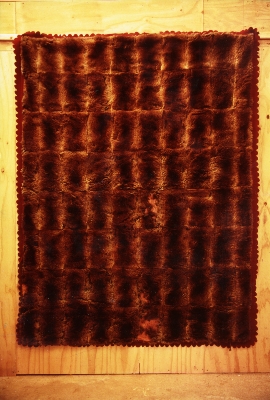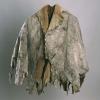Quilt No.173BM - Robert O'Hara Burke Memorial Museum
Owner:
Robert O'Hara Burke Memorial Museum
Location:
VIC North East
Maker
Maker:
Unknown
Made in
AUSTRALIA VIC
Patterms
Date:
1921 - 1940
Description:
Animal skin rug made from skins of the Long-footed Potoroo, the skins trimmed to rectangular shapes then stitched together. Backing and edging is of dark red felt.
1800 x 1500mm
History:
Maker unknown. Clive Crocker, the owner, found the rug in a box where he worked in Melbourne in the 1930s . Clive and Joyce Crocker lived in Beechworth. Donated to the Burke Museum, Beechworth (VIC) in 1982.
Story:
Corresondence from Burke Museum:
"The rug had been acquired by Clive through his work. In the 1930s he worked for a carrier in Fitzroy (Melbourne) and the rug had been found in abox where he worked, he kept it for many years and had finally decide to donate it to the Burke Museum in 1982."
The rug was originally thought to be made from possum or bandicoot skins. In 1998 the Victorian Department of Natural resources identified the hair as potoroo, and DNA testing confirmed the skins were those of the Long-footed Potoroo
Related Quilts:
Kangaroo skin cloak of seven gores is made from the skins of seven grey kangaroos (Macropus fuliginosus). The skins vary in size and shape, the inner five are roughly triangular. The cloak is edged with a series of loops, through one of these near the collar is a piece of cloth which appears to have tied the cloak together. The skins are sewn together with two sorts of linen or cotton thread. In a small diamond-shaped gusset at the back of the neck there are some stitches of sinew. The skins are sewn together by means of a small hem which was turned back on to the fur, so stitches went through two layers of skin on each gore. There are some small holes in the skins. The skins are very soft and pliable, and greyish in colour; they vary in size and shape.
Longest part: 800mm
Ref: MA Thesis 1973, S.Meagher 'A Reconstruction of the Traditional Life of the Aborigines of the S.W. of Western Australia.
3 fragments of koala bear skin joined with very fine stitching. Uneven edges. Thought to have been part of an aboriginal cloak or rug.
Skin rug made from feral cat skins and probably some wallaby pelts. There are 28 individual skins and colours are dark brown, creamy yellow and striped and spotted light and dark brown and cream. One cat pelt measures 495mm. The striped and spotted skins indicate tabby cats. The backing is maroon felt extended to form a pinked and scalloped edge. The top is attached to the backing with hand stitching incorporating faded red ric-rac braid along the seamline on the back.
1680 x 1300mm
Skin rug made from 50-60 rabbit skins in various colours, pieced in a diamond pattern. Dark diamond in centre, a diamond of dark honey colour, then a band of dark, another of dark honey, a band of grey, a band of honey, with corner triangles of grey. Rug is backed with blue felt, and has a scalloped edge of blue felt. Hand sewn. Skins tanned with wattle bark tanning solution.
1550 x 1300mm
Rug made of 12 lamb skins stitched to a blue and grey checked bush rug.
1931 x 1525mm
Possum skin rug. Skins are recantular centre back pieces, approximately 230mm x 140mm. They are hand stitched together in 11 rows running the length of the rug. At one end, the last row of skins goes across the rug. The backing is stitched to the skins and is mainly grey woollen material with a green piece added at one end. There is a scalloped edge and dark blue rat tail braid on the back 60mm from the edge.
2025 x 1400mm








